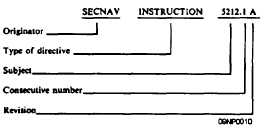| |
Figure 3-7.-Routing stamp
the order of issuance. For example, the subject number
of contract financing is 7810. An originating office
would assign numbers to the first, second, and third
instructions which it issues on contract financing as
follows: 7810.1,7810.2, and 7810.3, respectively. The
number 7810.1A indicates the first revision of the
instruction 7810.1.
Notices are not assigned consecutive numbers
when they are of a one-time nature or of brief duration.
The subject identification number assigned as the file
number of a letter is not assigned a consecutive number.
The security classification of Confidential or Secret
instructions and notices is indicated by prefixing the
subject number by “C” for Confidential and by “S” for
Secret.
Name-Title Subject Identification Codes
Name-title codes (alphabetic or alphanumeric
codes) are provided for names and titles frequently
used by the Department of the Navy. These codes
may be used for classifying and filing documents by
name or organizational designation except that they
are not to be used in assigning subject numbers to
directives.
Included are symbols for fleet
organizations, the United States Government, foreign
governments,commercial enterprises and firms;classes
of personnel; types of naval activities; and official
symbols for classes and types of aircraft, vessels, and
guided missiles.
The first letter of the name or title code designates
the larger organizational group, and the second or third
letter designates a further breakdown of the larger
group. For example, “NA” designates naval air
stations. The “N” is for the Naval Shore Establishment
and the “A” for air stations. An Arabic numeral added
to the letter symbol further subdivides the code. For
example: FF—Fleets, Forces, Types, Areas, and Sea
Frontiers. FF1—U.S. Fleet, FF3—U.S. Task Fleets.
Fleets
File arrangement within any office depends upon
the mission of the office and on the volume of its
official correspondence.
Normally, general
correspondence is stored in metal file cabinets., This
includes letters, and memorandums received or
originated by the office.
Folders are used to keep correspondence orderly in
the files. Standard file folders are available in two sires,
letter size (9 x 11-3/4 inches) and legal size (9 x 14-3/4
inches). The total number of folders and the appropriate
primary, secondary, or tertiary subject identification
numbers, or the name-title symbols, to be used are
determined by the volume of written matter in each
category to be filed. There may be no need to establish
folders on some major series groups, while others may
require several folders broken down to primary,
secondary, or tertiary numbers. The subject
identification numbers or name-title symbols should be
printed on each folder.
The subject identification number placed on the
correspondence by the originator assists in determining
the correct folder in which to file the correspondence.
This number, however, may not be appropriate for the
particular office concerned, thereby requiring
Figure 3-8.-Example of an identifying symbol assigned to an instruction.
3-14
|


